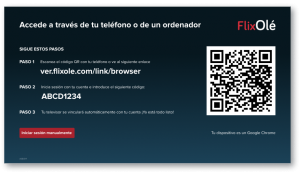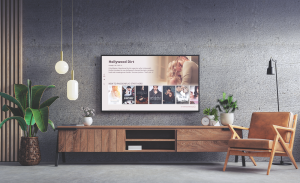
After more than 40 years of operation, DTVE is closing its doors and our website will no longer be updated daily. Thank you for all of your support.
Q&A: Matthew Wilkinson, CEO, Magine Pro, on the growing importance of Smart TV to streaming services
 DTVE: Why is the development of smart TV apps becoming more important for streaming service providers?
DTVE: Why is the development of smart TV apps becoming more important for streaming service providers?
MW: Let’s start with some history. Video services were previously dominated by cable, satellite and IPTV, using devices plugged into the back of the TV as the last part of the distribution chain. At the time TV manufacturers were focused and invested heavily in differentiating themselves by the quality of the screen (or screen products like 3D or curved TVs), as opposed to acting as a digital platform to enable distribution via apps – they lagged behind the curve when compared to mobile and tablet devices ecosystems.
Ten or so years ago, at the same time as OTT streaming services started to establish themselves firmly in the market, a new set of plug-in HDMI devices (Android, Chromecast) emerged to compete with classic distribution, as a means of giving consumers access to OTT services on TV devices, as older TVs didn’t have the app ecosystem at the time. Manufacturers anticipated the change, and rather than focus only on the hardware platforms, they established themselves as software platforms and app eco-systems, supporting the uptake of OTT services. That change was enabled by means of creating both modern software platforms (Tizen, WebOS), whilst also supporting the developer eco-system (following in the footsteps of Google Play store and Apple App store).
In general terms, TV manufacturer revenue was based on income from a hardware refresh life cycle of between seven and 10 years, but by building out capable software platforms (Tizen, WebOS, Vizio) which support a variety of OTT services and monetisation methods, for instance, ad revenue, manufacturers see an uptick in new recurring revenue. It makes complete sense for TV manufacturers to get into this game. You might argue that the consumer price of a TV is already or may be subsidised to get a footprint in a household, in return for wider service revenues (OTT/ad revenue).
For consumers, the buildout of better TV platforms has also increased the supply side (OTT apps) giving consumers a wider variety of quality apps. It’s also easier to consume content through the TV itself rather than lots of peripheral devices because the TV is the first thing you switch on – the TV interface is, by design, meant to keep you using TV platforms’ services, rather than switching to peripheral devices (why does Samsung TV tune into Samsung TV+ on startup?). In a similar light, media companies like Sky, who used to distributed over satellite, need to stay relevant, regardless of the means of distribution (satellite, cable, IPTV, OTT) ,they recognise this, and have sought to stay “in the home” through Sky Glass (their own TV and software platform), so that when people come round to replacing their set-top box they replace it with a subscription to the TV that sits in your living room.
DTVE: To what extent do you think users will turn to native smart TV apps rather than HDMI-connected devices and why?
MW: It comes down to user experience, eliminating user friction and is also a function of hardware refresh cycles as described before. On the consumer side, over time, users will refresh TV devices, and as a function of that, will have newer TV app ecosystems, through which to select new apps. You can ask the question, “if I have Netflix as a native app on my Samsung TV, why should I turn on my TV, start up my Chromecast, and cast from my phone, or use my Android STB to open the Netflix app?” There is reduced user friction. On the supply side from the manufacturers, and with greater scale and volume of smart TVs, they in turn attract a larger number of OTT platforms into their own TV app eco-system, so these smart TV platforms become a ‘must have’ distribution point, rather than a ‘nice to have’ app.
DTVE: What challenges do streamers face in developing native apps for multiple smart TV platforms, and how does this compare with developing apps for streaming sticks and set-tops?
MW: If we start with a typical html based set-top box, the underlying web technology and frameworks implemented are typically dependent on the manufacturer. Despite many being based on HTML technologies, there can be huge fragmentation as to the software frameworks supported on each device. So, developing for set-top boxes means more customisation, not only because of variations in the underlying frameworks but sometimes also because of hardware constraints. Moving onto platforms that are more widely adopted across hardware devices and as TV platforms (such as Roku, Android TV) the ability to scale development across these devices becomes easier, since there is more maturity in the platforms and underlying hardware uniformity and support. Lastly, while it is still challenging to develop apps for LG, Samsung, Vizio TVs where quality assurance is incredibly rigorous, working with platforms that are better scaled provides a more comprehensive development environment.
DTVE: How does the smart TV UX differ from other devices and what, if any, advantages does it offer to streaming providers?
MW: Beyond the physical interface (keyboard, touchscreen, remote), one of the bigger differences is that content discovery is generally a shared experience, with possibly three or four people in the room deciding what to watch. Streaming providers may design around this shared discovery experience, by recommending content above and beyond the user profile that is logged in. In addition, due to the limitations of the remote control as the interface to the smart TV apps, navigation through the app needs careful consideration, so that users don’t end up deep into the service without being able to navigate back to the home screen. No-one likes getting ‘lost in an app’. Beyond this, there is also an expectation and need to have some uniformity of experience between apps and platforms – common design patterns also enable simplicity for the users.
 DTVE: What needs to be done to enable new users to sign on to services easily via their smart TVs?
DTVE: What needs to be done to enable new users to sign on to services easily via their smart TVs?
The biggest source of friction when onboarding a user to a smart TV app, is user login or user registration – any time a user needs to enter text into the app when the remote has no keypad adds more friction and frustration when we have myriad passwords to remember with special characters. How do we reduce this friction? ‘Off device’ (laptop, mobile phone) authentication methods i.e. by directing a user to a web URL, using a QR code to ease the redirection to a URL via a smart phone, and even deep linking to installed apps. The easier it is for a user to get into the service, the better the conversion will be, with fewer tickets raised to customer service and fewer frustrated customers.
DTVE: What should service providers think about in deciding whether to outsource app development to an external provider such as Magine Pro?
MW: Ultimately this will be a decision based on the Total Cost of Ownership and return on investment. Going down the CAPEX route and developing your own apps can be costly up front. However you have full control of the UX/UI and own the intellectual property to some extent. Development lifecycles can be longer, ongoing maintenance costs higher, and for each new feature, there will be a new fee for development. A further consideration is that you may also need some in-house competence to drive the requirements toward the development teams. While you may own intellectual property that you invest in yourself, that may be somewhat limited because you’re tying your app to a particular back-end platform. If, in the future, you want to change to another platform you’re going to have to absorb those costs again to integrate to a new platform.
As a SaaS platform, Magine takes all the CAPEX costs, and provides apps at a much lower recurring fee. There is of course a trade off. You do get a huge amount of flexibility in the apps, the ability to configure and customise, but then you don’t have full control of every aspect (e.g. if you want a drop shadow on a font, that might not be immediately available). The upside is that it’s low-cost, and it covers the headache of ongoing maintenance and updates, as well as the rollout of new features.
This is sponsored content.



